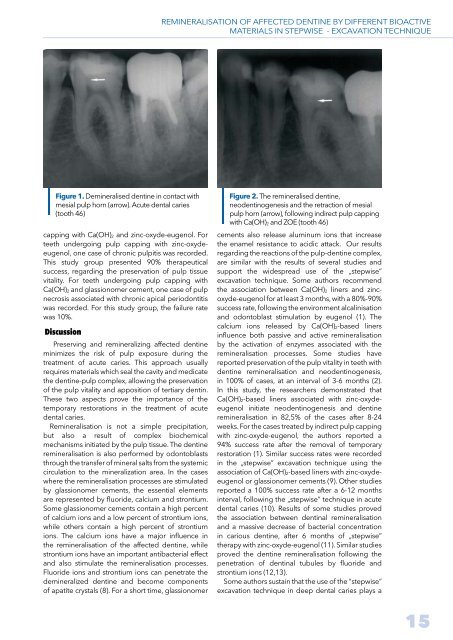Stomatology Edu Journal 1/2014
Create successful ePaper yourself
Turn your PDF publications into a flip-book with our unique Google optimized e-Paper software.
REMINERALISATION OF AFFECTED DENTINE BY DIFFERENT BIOACTIVE<br />
MATERIALS IN STEPWISE - EXCAVATION TECHNIQUE<br />
Figure 1. Demineralised dentine in contact with<br />
mesial pulp horn (arrow). Acute dental caries<br />
(tooth 46)<br />
capping with Ca(OH) 2 and zinc-oxyde-eugenol. For<br />
teeth undergoing pulp capping with zinc-oxydeeugenol,<br />
one case of chronic pulpitis was recorded.<br />
This study group presented 90% therapeutical<br />
success, regarding the preservation of pulp tissue<br />
vitality. For teeth undergoing pulp capping with<br />
Ca(OH) 2 and glassionomer cement, one case of pulp<br />
necrosis associated with chronic apical periodontitis<br />
was recorded. For this study group, the failure rate<br />
was 10%.<br />
Discussion<br />
Preserving and remineralizing affected dentine<br />
minimizes the risk of pulp exposure during the<br />
treatment of acute caries. This approach usually<br />
requires materials which seal the cavity and medicate<br />
the dentine-pulp complex, allowing the preservation<br />
of the pulp vitality and apposition of tertiary dentin.<br />
These two aspects prove the importance of the<br />
temporary restorations in the treatment of acute<br />
dental caries.<br />
Remineralisation is not a simple precipitation,<br />
but also a result of complex biochemical<br />
mechanisms initiated by the pulp tissue. The dentine<br />
remineralisation is also performed by odontoblasts<br />
through the transfer of mineral salts from the systemic<br />
circulation to the mineralization area. In the cases<br />
where the remineralisation processes are stimulated<br />
by glassionomer cements, the essential elements<br />
are represented by fluoride, calcium and strontium.<br />
Some glassionomer cements contain a high percent<br />
of calcium ions and a low percent of strontium ions,<br />
while others contain a high percent of strontium<br />
ions. The calcium ions have a major influence in<br />
the remineralisation of the affected dentine, while<br />
strontium ions have an important antibacterial effect<br />
and also stimulate the remineralisation processes.<br />
Fluoride ions and strontium ions can penetrate the<br />
demineralized dentine and become components<br />
of apatite crystals (8). For a short time, glassionomer<br />
Figure 2. The remineralised dentine,<br />
neodentinogenesis and the retraction of mesial<br />
pulp horn (arrow), following indirect pulp capping<br />
with Ca(OH) 2 and ZOE (tooth 46)<br />
cements also release aluminum ions that increase<br />
the enamel resistance to acidic attack. Our results<br />
regarding the reactions of the pulp-dentine complex,<br />
are similar with the results of several studies and<br />
support the widespread use of the „stepwise”<br />
excavation technique. Some authors recommend<br />
the association between Ca(OH) 2 liners and zincoxyde-eugenol<br />
for at least 3 months, with a 80%-90%<br />
success rate, following the environment alcalinisation<br />
and odontoblast stimulation by eugenol (1). The<br />
calcium ions released by Ca(OH) 2-based liners<br />
influence both passive and active remineralisation<br />
by the activation of enzymes associated with the<br />
remineralisation processes. Some studies have<br />
reported preservation of the pulp vitality in teeth with<br />
dentine remineralisation and neodentinogenesis,<br />
in 100% of cases, at an interval of 3-6 months (2).<br />
In this study, the researchers demonstrated that<br />
Ca(OH) 2-based liners associated with zinc-oxydeeugenol<br />
initiate neodentinogenesis and dentine<br />
remineralisation in 82,5% of the cases after 8-24<br />
weeks. For the cases treated by indirect pulp capping<br />
with zinc-oxyde-eugenol, the authors reported a<br />
94% success rate after the removal of temporary<br />
restoration (1). Similar success rates were recorded<br />
in the „stepwise” excavation technique using the<br />
association of Ca(OH) 2-based liners with zinc-oxydeeugenol<br />
or glassionomer cements (9). Other studies<br />
reported a 100% success rate after a 6-12 months<br />
interval, following the „stepwise” technique in acute<br />
dental caries (10). Results of some studies proved<br />
the association between dentinal remineralisation<br />
and a massive decrease of bacterial concentration<br />
in carious dentine, after 6 months of „stepwise”<br />
therapy with zinc-oxyde-eugenol (11). Similar studies<br />
proved the dentine remineralisation following the<br />
penetration of dentinal tubules by fluoride and<br />
strontium ions (12,13).<br />
Some authors sustain that the use of the “stepwise”<br />
excavation technique in deep dental caries plays a<br />
15




